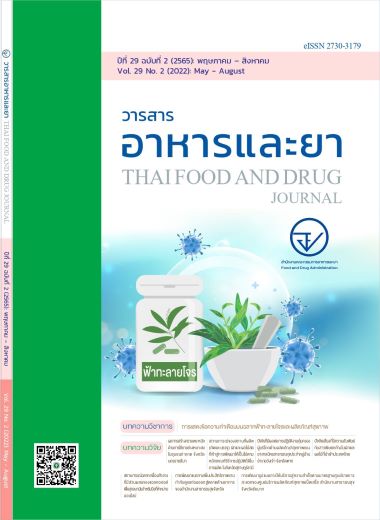ผลการสร้างความตระหนักด้านการใช้ยาอย่างเหมาะสมในชุมชนท่าลาด จังหวัดนครราชสีมา
Main Article Content
บทคัดย่อ
ความสำคัญ: ปัญหาความไม่ปลอดภัยจากการใช้ยาในชุมชน สาเหตุหนึ่งเกิดจากการมีแหล่งจำหน่ายยาที่ไม่เหมาะสมซึ่งผิดกฎหมายกระจายอยู่ทั่วไปในชุมชน โดยเฉพาะร้านชำในหมู่บ้านที่เข้าถึงได้ง่าย ดังนั้นการให้ความรู้และสร้างความตระหนักให้ผู้ขายอาจมีผลต่อการลดปัญหา
วัตถุประสงค์: เพื่อเปรียบเทียบความรู้ด้านยาของผู้ประกอบการร้านชำก่อนและหลังการอบรมให้ความรู้ ศึกษาความชุกการจำหน่ายยาและชนิดของยาที่ไม่เหมาะสมในร้านชำ และการเกิดอาการไม่พึงประสงค์จากการใช้ยา
วิธีการวิจัย: เป็นการวิจัยแบบ Pre-post intervention ใช้ประชากรร้านชำทุกแห่งในพื้นที่ตำบลท่าลาด อำเภอชุมพวง จังหวัดนครราชสีมา จำนวน 84 คน โดยสร้างความตระหนักรู้เรื่องการใช้ยาอย่างเหมาะสมใช้ระยะเวลา 2 ชั่วโมง โดยการอบรมเกี่ยวกับความรู้เรื่องยา ประเภทของยาตามกฎหมาย ยาที่ห้ามจำหน่ายและยาที่สามารถจำหน่ายได้ในร้านชำ การใช้ยาตามข้อบ่งใช้ ขนาดและข้อควรระวังในการใช้ยา การใช้ยาในผู้ป่วยกลุ่มพิเศษและการเก็บรักษายา จำนวน 1 ครั้ง จากนั้นวัดผลคะแนนความรู้เปรียบเทียบก่อนและหลังการอบรม พร้อมกับสำรวจการจำหน่ายยาไม่เหมาะสมในร้านชำช่วงก่อนและหลังอบรมที่เวลาห่างกัน 1 เดือน และติดตามการเกิดอาการไม่พึงประสงค์จากการใช้ยาระหว่างเดือนมกราคม – มีนาคม 2564
ผลการศึกษา: ผู้ประกอบการร้านชำ 84 ร้าน เป็นเพศหญิง ร้อยละ 72.6 มีอายุเฉลี่ย 51.56 ปี เป็นร้านค้าปลีก ร้อยละ 94.1 ส่วนแหล่งที่รับยามาจำหน่ายมาจากร้านขายยา ร้านขายส่ง และรถเร่ ร้อยละ 59.5, 32.1 และ 8.3 ตามลำดับ ก่อนการอบรมพบว่ากลุ่มตัวอย่าง ร้อยละ 76.2 มีความรู้ด้านยาอยู่ในระดับปานกลาง และร้อยละ 7.1 อยู่ในระดับสูง แต่หลังอบรมพบว่าปรับขึ้นอยู่ในระดับสูงถึงร้อยละ 57.1 ซึ่งพบว่ามีค่าคะแนนเฉลี่ยเพิ่มขึ้นอย่างมีนัยสำคัญทางสถิติที่ p-value<0.001 โดยเพิ่มจาก 7.8 เป็น 10.5 คะแนน จากคะแนนเต็ม 20 คะแนน หัวข้อความรู้ที่เพิ่มขึ้นอย่างมีนัยสำคัญ ได้แก่ ประเภทยาที่จำหน่ายได้และจำหน่ายไม่ได้ในร้านชำ การอ่านเครื่องหมายเลขทะเบียนยาและการอ่านฉลากยาอันตราย การอ่านวันหมดอายุของยา การใช้ยาปฏิชีวนะ การใช้ยาในหญิงตั้งครรภ์ หญิงให้นมบุตร และการจัดเก็บยาที่ถูกต้อง เมื่อสำรวจร้านชำที่มีการจำหน่ายยาไม่เหมาะสมพบว่าลดลงอย่างมีนัยสำคัญทางสถิติที่ p-value <0.001 โดยลดลงจากร้อยละ 61.9 เหลือร้อยละ 46.4 ประเภทยาที่เป็นปัญหาและยังพบในร้านชำ ได้แก่ ยาอันตราย ยาปฏิชีวนะ และยาแผนโบราณ และไม่พบรายงานการเกิดอาการไม่พึงประสงค์จากการใช้ยาในช่วงมกราคม – มีนาคม 2564
สรุป: การสร้างความตระหนักเรื่องการใช้ยา ช่วยทำให้ผู้ประกอบการร้านชำมีความรู้ด้านยาเพิ่มขึ้นอย่างมีนัยสำคัญทางสถิติ และมีการขายยาไม่เหมาะสมลดลง ทั้งนี้ เพื่อลดปัญหาการใช้ยาอย่างไม่เหมาะสมในชุมชนผู้ประกอบการควรได้รับการอบรมความรู้ด้านยาอย่างต่อเนื่องและสม่ำเสมอ ประชาชนควรได้รับความรู้ด้านการใช้ยาอย่างสมเหตุผลเพื่อสร้างความตระหนัก ชุมชนควรมีส่วนร่วมในกำหนดมาตรการในการแก้ไขปัญหา และภาครัฐควรเข้ามามีบทบาทในการบังคับใช้กฎหมายอย่างจริงจัง
Article Details

อนุญาตภายใต้เงื่อนไข Creative Commons Attribution 4.0 International License.
เอกสารอ้างอิง
World Health Organization. The world medicines situation [Internet]. Geneva: WHO. 2011 [cited 2021 Jan 9]. Available from: https://www.who.int/medicines/areas/policy/world_medicines_situation/WMS_ch6_wPricing_v6.pdf
สำนักงานกฤษฎีกา. พระราชบัญญัติยา พ.ศ. 2510 (ฉบับปรับปรุงล่าสุด) [อินเทอร์เน็ต]. 2562 [เข้าถึงเมื่อ 10 ก.พ. 2564]. เข้าถึงได้จาก: https://www.fda.moph.go.th/sites/drug/LawDrug/drug2510-krisdika-v2020.pdf
เบญจมาศ บุดดาวงศ์, นิยดา เกียรติยิ่งอังศุลี, ขนิษฐา วัลลีพงษ์, ลัทธิพร บุญมานัส, อรวรรณ กาศสมบูรณ์, จันทร์จรีย์ ดอกบัว, และคณะ. แหล่งต้นทางและเส้นทางการกระจายยาไม่เหมาะสมในชุมชนจาก 8 จังหวัด สู่ข้อเสนอเชิงนโยบายในการแก้ไขปัญหาการกระจายยาไม่เหมาะสมเชิงระบบ. วารสารเภสัชศาสตร์อีสาน 2559;11(ฉบับพิเศษ):260-8.
สมหญิง พุ่มทอง. รายการสรุปผลการดำเนินงานโครงการส่งเสริมการใช้ยาปลอดภัยในชุมชน ปี 2561- 2562 [อินเทอร์เน็ต]. 2562 [เข้าถึงเมื่อ 10 ก.พ. 2564]. เข้าถึงได้จาก: http://ndi.fda.moph.go.th/uploads/sensible_file/20191118101736.pdf
วราภรณ์ สังข์ทอง. ความชุกของร้านชำที่จำหน่ายยาปฏิชีวนะในเขตอำเภอแม่สรวย จังหวัดเชียงราย และปัจจัยที่ทำให้เกิดการจำหน่าย. วารสารเภสัชกรรมไทย 2558;7(1):38-46.
นทพร ชัยพิชิต, นฤมล เจริญศิริพรกุล, ผันสุ ชุมวรฐายี. ความรู้ ความเข้าใจต่อการแพ้ยา และพฤติกรรมการพกบัตรแพ้ยาของผู้ป่วยแพ้ยาในโรงพยาบาลศรีนครินทร์. ศรีนครินทร์เวชสาร 2552;24(3):224-30.
รัชตะ รัชตะนาวิน, ชะอรสิน สุขศรีวงศ์, เพชรรัตน์ พงษ์เจริญสุข, ละออ ชัยลือกิจ, อัมรินทร์ ทักขิญเสถียร. การศึกษาความชุกของปัญหาทางคลินิกที่เกิดจากการใช้สารที่มีสเตียรอยด์ ปะปนโดยไม่มีข้อบ่งชี้ทางการแพทย์ (รายงานวิจัยฉบับสมบูรณ์). กรุงเทพฯ: สำนักงานกองทุนสนับสนุนการวิจัย; 2550.
Kongkaew C, Methaneethorn J, Mongkhon P, Dechanont S, Taburee W. Drug-related problems identified at patients' home: a prospective observational study in a rural area of Thailand. Journal of Patient Safety 2017;17(1):8-14.
องค์การบริการส่วนตำบลท่าลาด. ข้อมูลหน่วยงาน. 2563 [อินเทอร์เน็ต]. 2564 [เข้าถึงเมื่อ 10 ก.พ. 2564]; เข้าถึงได้จาก:http://taladlocal.go.th/ประวัติความเป็นมา
โรงพยาบาลชุมพวง. รายงานการเกิดอาการไม่พึงประสงค์จากการใช้ยา 2563. นครราชสีมา: ชุมพวง; 2563.
ปัทมาพร ปัทมาสราวุธ, รุ่งทิวา หมื่นปา. การพัฒนาร้านชำต้นแบบจากโครงการประชารัฐร่วมใจส่งเสริมการใช้ยาอย่างปลอดภัยในชุมชน. วารสารเภสัชกรรมไทย 2563;12(3):601-11.
อัญชลี ชมภู, สุรสิทธิ์ สุรินทร์. โครงการการดำเนินงานเฝ้าระวังการจำหน่ายยาอันตรายในร้านชำของกลุ่มงานคุ้มครองผู้บริโภคด้านสาธารณสุขในพื้นที่รับผิดชอบโรงพยาบาลแม่สะเรียง. วารสารอาหารและยา 2558;22(1):45-50.


